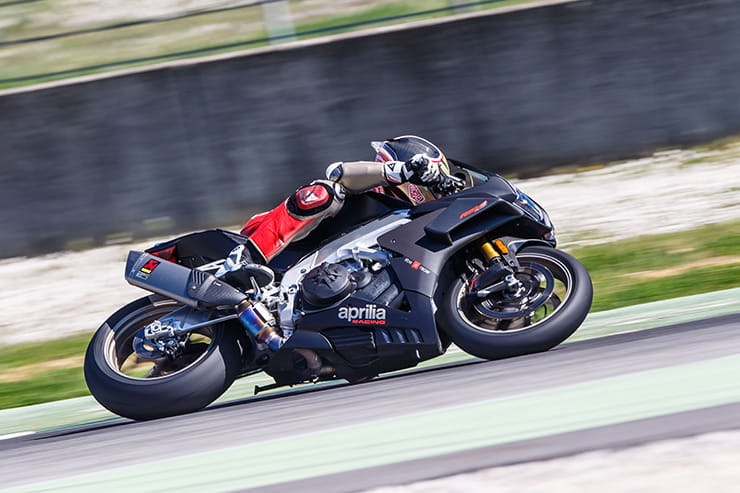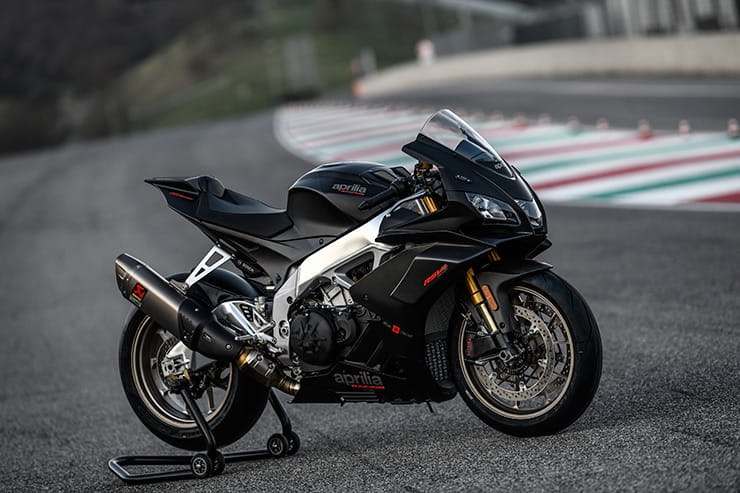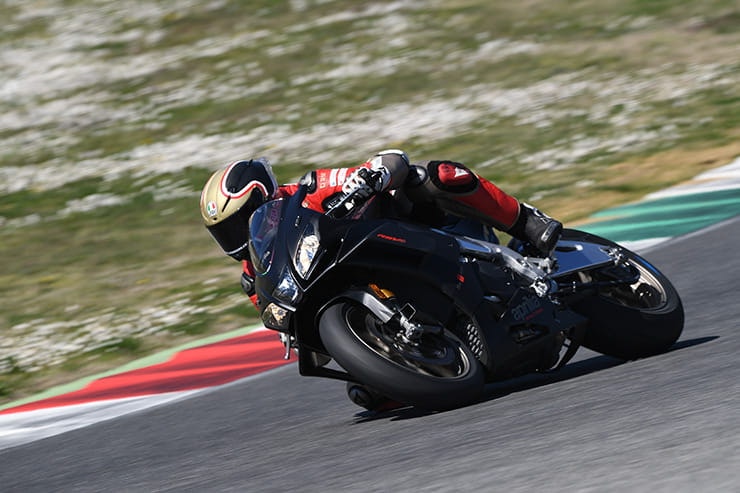Aprilia RSV4 1100 Factory (2019) - Review
By Michael Mann
BikeSocial Managing Editor
26.03.2019
KIT CREDITS
One-piece Leathers
Dainese D-air Racing Mugello, £2,799.95 | www.dainese.com
(Custom fit and personalised via Dainese Custom Works)
Boots
Dainese R Axial Pro In, £339.95 | www.dainese.com
Gloves
Dainese Full Metal 6, £299.95| www.dainese.com
The various guises of RSV4 sports bikes from Aprilia from the last 10 years have received plaudits the world over, winning many media group tests against fearsome, bhp-laden, weapons from Japan, Italy and Germany. Yet there’s little correlation between awards and sales care of a smaller dealer network and reports of technical gremlins. However, out of the Noale-based firm for 2019 comes the RSV4 1100 Factory to replace the RF model. Instantly recognisable courtesy of its carbon fibre winglets straight from the firms’ MotoGP bike, and a first on a road bike.
Its factory name and factory spec sheet offer an air of exclusivity for this premium placed motorcycle. Peak power outranks anything else on the road-going superbike market, just edging the Panigale V4, although it is the Ducati that comes out on top with peak torque. Aprilia have cunningly priced their latest weapon right in between the base model Panigale V4 and the V4S.
Still, the RSV4 1100 Factory is 16hp more powerful than the 1000cc RF, it offers 7Nm more torque yet weighs 5kg less. It’s premium, it’s pure and it’s packed full of top spec goodies. When you hear words like carbon, titanium, forged aluminium, winglets, Ohlins, Brembo and Akrapovic used in a spec sheet, you know this is going to be something special.
Off to Mugello, one of the world’s greatest race tracks, we went to enjoy four 20-minute sessions at the International Press Launch to see what all the fuss was about.
2019 Aprilia RSV4 1100 Factory press launch
At the press launch, Michael Mann shows you around the fastest, lightest and most powerful production RSV ever made, takes you on-board and discusses his first impressions.
Above: Looks fast standing still
2019 Aprilia RSV4 1100 Factory Price
For the hi-spec level of performance and electronics, the Aprilia is healthily priced among competitors with a price tag of £21,499. It’s available in just the one colour scheme, known as Atomico 6, and is in dealerships now. Other bhp-laden road-going sports bikes from Ducati, BMW, Kawasaki, Honda and Kawasaki are all around the £20k mark. In fact, the V4S is more than £2,000 more than the new RSV4 1100 Factory.
This example of a finance deal from Wheels of Peterborough is spread over 49 months with payments of sub-£290 with a £3500 deposit:
Above: 1078cc’s make 214bhp
Power and torque
It’s easy to write nonchalantly about a motorbike that makes 214bhp but just read those numbers back to yourself again. 2.1.4. It wasn’t long ago that we were talking about the magic 200bhp marker being surpassed, yet as each model year passes, the manufacturers keep wowing us with even more impressive stats and ways in which to control it all – it seems counterproductive somehow; give a bike more horsepower causes more work on the electronics to harness it all. Nevertheless, while the 1000cc RSV4 RR/RF bikes are the basis for Superstock and Superbike racing, it’s the 1100 Factory that shows just what the Italian’s can do by creating the “fastest, lightest and most powerful RSV4 ever”, according to the PR man.
What we end up with is claimed figures of 214bhp (159.6kW) at 13,200rpm and 90lb-ft (122Nm) at 11,000rpm. Yes, 2.1.4. The thing is, that’s not too much to handle. On track and the delivery is sweet, smooth and controllable thanks to the electronic magic and the composed handling. The fuelling is faultless, throttle connection sublime, instant and with not even a hint of jerkiness when rolling off. Redesigned butterfly support of the throttle body shaft will certainly have helped.
Engine, gearbox and exhaust
So how has Aprilia turned the RSV4 from a 999cc machine to a 1078cc one? It’s a fairly simple case of increasing the bore (aka piston diameter) from 78mm to 81mm, while leaving the stroke unchanged at 52.3mm. A little bit of redesigning with the top parts and a compression ratio of 13.6:1 was achieved. The firm did the same with the naked Tuono back in 2015, so creating an RSV4 1100 was a relatively simple job. Improvements to the injection and intake and a new engine map courtesy of the Magneti Marelli 7SM ECU ups the rev limit to 13,600rpm accounts for the improved power compared to the 173bhp Tuono 1100, which peaks at only 11,000rpm.
And what you have is a top-class motor strapped to a top-class chassis with a fine quickshift and autoblipper-enabled gearbox that has the ability to warp its riders’ senses but realistically provides all the thrust while seemingly relaxed and undisturbed. At the end of the Mugello start/finish straight, over the crest and into the braking zone for turn one and I managed to glimpse at an indicated figure of 306kph (190mph) but it seemed so easy to get there. No madness, instability or too much screaming from the V4. 5th and 6th gear ratios have been lengthened to match the Tuono’s which accounts for some missing speed because as long as the Grand Prix circuit’s main straight is, there was more to come from the RSV4. Pin the throttle out of the last corner in third and the revs run out quickly after the peak power of 13,200rpm so the timing of the upshift is crucial to carry to the speed down the straight.
Such is the improvement to the torque right across the range that gear selection can mean one higher than normal. Most test bikes were on road shift pattern (although race shift is not a tricky accessory-based conversion, I’m told) and holding third around the final corner was certainly beneficial to miss that awkward rev limiter bounce while getting all the power on as you pick the bike up and roar off, snicking up to top gear by the start/finish line.
I used Track mode for the first couple of sessions before seeing what Race mode was all about. The only noticeable difference was the slightly less intrusive engine braking. I set Traction Control to ‘4’ of the eight settings and found it just fine for my ability, it kept me in check without hindering performance too much.
If you’ve not listened to the V4 roar on track yet via our social media channels then get to it now and turn your speakers up. The new exhaust system is fitted with a titanium Akrapovic muffler replacing that humungous great thing on the RR/RF, and it has that deep, throaty burble at low revs which becomes a higher pitched roar as the engine spins its way towards peak revs. Classy, orchestral and downright rude as the decibels ricocheted around the Italian hills!
Above: easy steering from the incredible chassis
Handling, suspension, chassis and weight
Tweaks to the 1100’s frame include new steering bushes that reduce the head angle and take 4mm off the wheelbase, while the Ohlins NIX forks get 5mm more travel than before and the swingarm has been make more rigid. Brembo’s latest Stylema calipers, as seen on the Panigale V4, replace the previous M50 stoppers, and there’s the option of carbon brake ducts if you need extra cooling due to the position of the brake calipers.
While most of the panels are unchanged, the RSV4 1100 Factory gains MotoGP-style winglets on the fairing, said to increase stability at high speed, improve braking and reduce the tendency to wheelie out of corners.
Mugello might just be the greatest circuit on the planet and when you have an epically capable motorcycle underneath you that faces the challenge of the 100mph+ uphill sweeping Arrabbiata 1 with the dexterity of a Chinese acrobat then happiness is guaranteed. I finished the session, exhaled as I trundled down pit lane and wondered if life could get any better. The RSV4 1100 Factory is a very easy bike to ride. The 851mm seat height does feel tall when you first hop on and if you’re more than 6ft tall there’s a chance it will feel a little cramped. I didn’t have a problem but another 6-footer mentioned it and one other at 6”4’ complained of a short gear selector blaming it for a couple of neutrals. I, however, found nothing but the gear I wanted. And, with a sweet, short throw and minimal effort. Even on the way down from 6th to 2nd for turn one, the Aprilia’s ‘box and slipper clutch more than met my expectations.
The already awesome RSV4 chassis coupled with the fine standard of components including Ohlins suspension and Pirelli Supercorsa SC2 (front) and SC1 (rear) tyres have formed an incredibly successful team to offer handling capability like no other. The bike is so stable under hard braking, in the slow and fast corners plus under acceleration. It’s flattering, faultless and forgiving making riders of any standard feel like a superbike hero. Until Max Biaggi slides up the inside at Palagio, turn 11, and disappears like I’m only running on 50% power… but then his racing CV is pretty good!
What’s more, there’s plenty of adjustability with engine height, swing arm pivot, steering angle and triple clamp for that extra degree of personalisation. While rubber inserts inside the frame reduces noise and the swing arm is braced for added stability on the power out of a corner. You can be quite ruthless with the bike because it provides such confidence. The Ohlins NIX forks and TTX rear shock are fully adjustable and, on this display, have been tuned for maximum track performance. It’ll be interesting to see how they cope with a little Fenland cruise.
The bike is 5kg lighter than the RF model, half of which is courtesy of a lithium battery, which leads to a wet weight of 199kg and on a par with the Ducati although 5.5kg heavier than BMW’s S1000RR (with its M Package). What is apparent having recently ridden the German entrant, is how close these two bikes are going to be, and when you include a Panigale V4S things are going to get interesting.
Above: Super bike, super circuit
2019 Aprilia RSV4 1100 Factory Brakes
A new front brake caliper known as ‘Stylema’ by Brembo has been seen on the Panigale V4 and makes its way on the Aprilia this year, replacing the M50’s, coupled with new brake pads, all of which reduce weight yet allow for increased ventilation, helps maintain consistent performance and allows for more aggressive application.
Located behind forks, the optional accessory carbon fibre cooling ducts not only look GP-spec but do a job too. Also helping with stability under braking are those carbon fibre winglets as seen on the RS-GP bike and come as standard on the RSV4 1100 Factory.
Overall, I could not have been more impressed with the quality of brake feel, lack of brake fade and stability under hard braking. On a bike full of extreme components, the brakes stand out as being some of the finest I’ve ever used. Even on my fourth and final track session of the day, which was the bike’s eighth, there was no difference in quality of performance. Something that you certainly have faith in at +190mph approaching turn one.
Above: striking detail throughout
Rider aids and extra equipment / accessories
As ever, there’s a top-level suite of electronic goodies, including traction control, wheelie control, launch control, quick shifter, pit lane limiter, cruise control and cornering ABS. New for 2019 is an infotainment system, offered as an accessory, that connects the bike’s TFT dash to your phone via Bluetooth and creates a full datalogger as well as giving access to calls on your phone.
The TFT screen is brighter than before although what is a little disappointing, considering the real quality throughout the rest of the bike, is the unchanged switchgear layout which aren’t the easiest to familiarise yourself with. That said, the + and – buttons either side of the left handlebar to alter traction settings are a doddle to use. Though I think a next generation seamless shift gearbox should be utilising those buttons instead…
The thirteen or so official accessories include a tank bag, carbon heel guard, USB socket and racing levers.
Above: Aprilia give you wings
Rivals
Who says sportsbikes are dead? The way in which manufacturers keep churning out top quality crotch rockets would have you believe the aspirational side of motorcycling is still alive, kicking and well. £20k will get you an awful lot of bhp’s, nm’s and electronic goodness to look after you. And, with BMW bringing a new S1000RR to market this calendar year, it’s the Europeans who are leading the way. A new R1 is expected in 2020 as is Honda’s Fireblade but they’ve got some work to do to match the ability of Aprilia’s RSV4 1100 Factory.
For a quick comparison, I reckon the following four would give the strongest rivalry to the Aprilia. Honda’s SP2 Fireblade and Suzuki’s GSX R1000R are worthy of note too:
Above: Perfectly poised at Mugello
2019 Aprilia RSV4 1100 Factory verdict
Of all the road bikes I’ve ever ridden on track, I’ve always had a soft spot for the RSV4 range – and this version just takes my breath away with its cutting-edge electronics, eye-watering composure in the bends and under braking, not to mention the glorious way it propels you towards the next corner with such aplomb and dexterity. Oh, and that beautiful V4 throaty roar is so defining.
Aprilia have worked wonders with an already sublime and accessible machine by adding a boxful of premium components, a sophisticated finish and top level ability. It’s just a shame that UK roads won’t get to witness the extraordinary levels of just how good it is. Some may complain about the lack of colour in its appearance and there’s always the historic dealer network issue but believe me, this is a bike that has the potential to blow every other road-going machine out of the water. Factory by name, full factory by nature.
Three things I loved about the 2019 Aprilia RSV4 1100 Factory…
Sublime chassis and handling
Silky power delivery
Outrageous track ability
Super strong brakes
Noise
Controllability
The way it makes you feel
…oh, wait I was only supposed to write three
Three things that I didn’t…
Only one colour option
Not the easiest instrument panel to operate nor is it the most 21st century in appearance
Lack of semi-active suspension/slide control to match rivals
2019 Aprilia RSV4 1100 Factory spec
To learn more about what the spec sheet means, click here for our glossary


